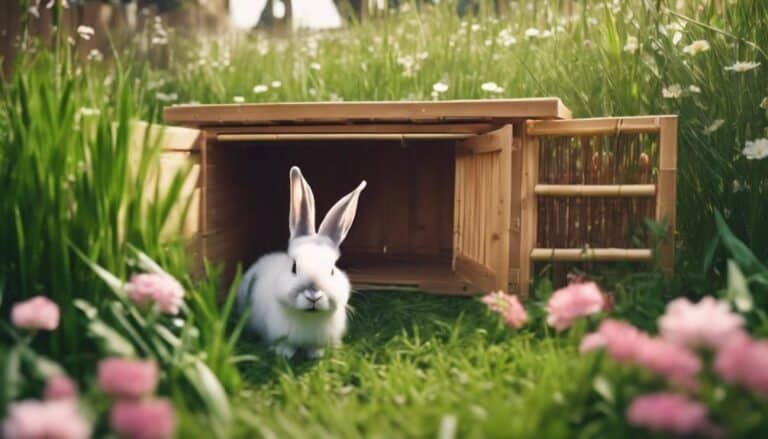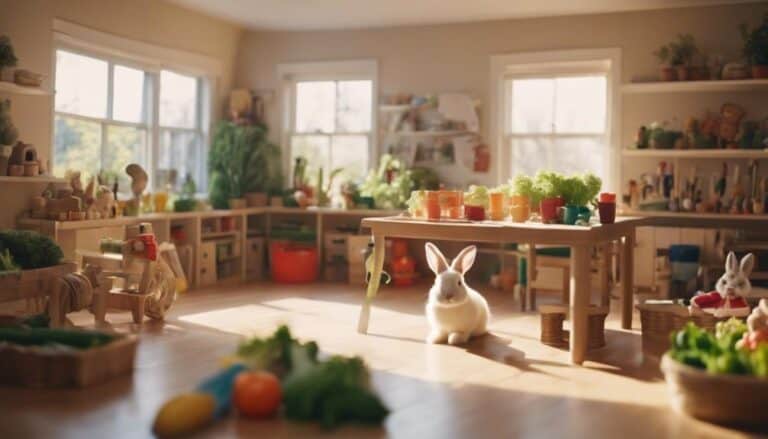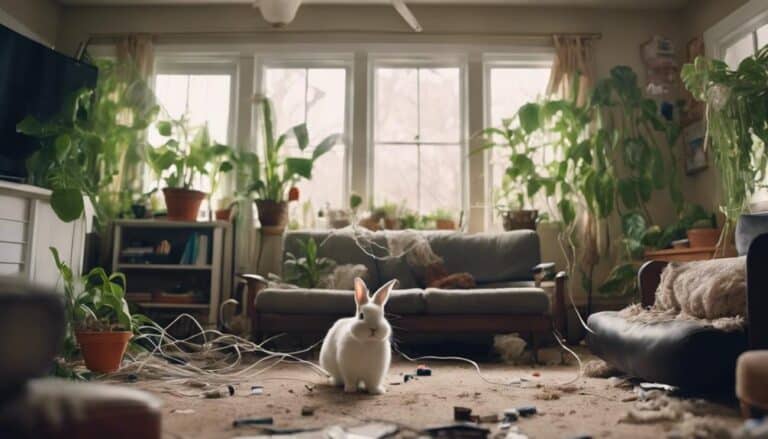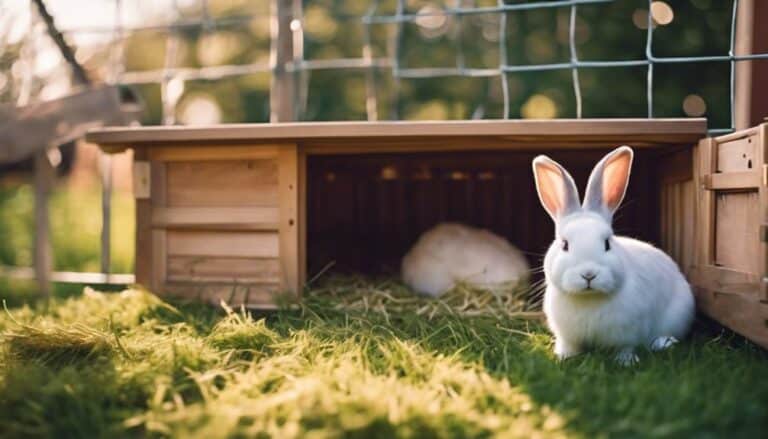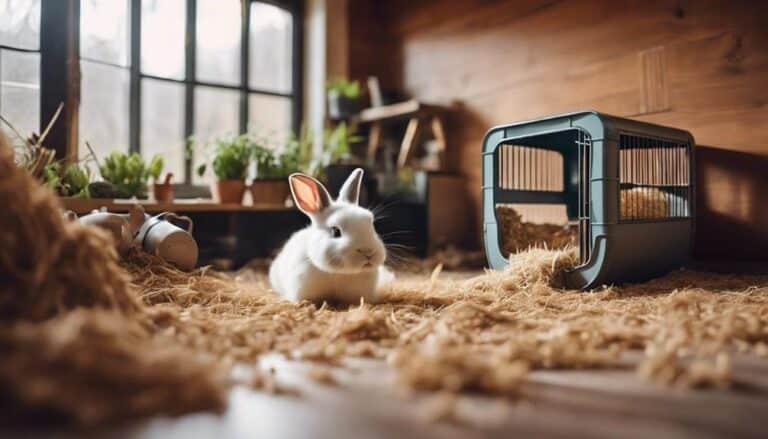You may think your bunny is safe, but the reality is, hazards can be lurking in unexpected places. From common household items to outdoor dangers, the well-being of your furry friend is at stake.
By being proactive and implementing simple yet effective safety measures, you can provide a secure environment for your bunny to thrive.
Stay tuned to discover essential tips and practices that will help you navigate the potential hazards that could jeopardize your bunny's safety and happiness.
Contents
- 1 Key Takeaways
- 2 Bunny-Proofing Your Living Space
- 3 Electrical Wire Safety Measures
- 4 Safe Plant Choices for Bunnies
- 5 Pet-Safe Food Practices
- 6 Non-Toxic Cleaning Alternatives
- 7 Creating a Bunny-Safe Play Area
- 8 Eliminating Slippery Surfaces
- 9 Ensuring Proper Ventilation and Temperatures
- 10 What Hazards Should I Be Aware of to Keep My Bunnies Safe?
- 11 Frequently Asked Questions
- 12 Conclusion
Key Takeaways
- Secure bunny environment from hazards like toxic plants and wires.
- Provide a safe diet and environment with proper cleaning measures.
- Ensure a hazard-free play area with safe toys and flooring.
- Maintain optimal air quality and comfort for bunny well-being.
Bunny-Proofing Your Living Space

To guarantee the safety of your beloved bunnies, start by bunny-proofing your living space with these essential precautions. Rabbits are curious creatures that love to explore, but this can sometimes lead them into hazardous situations within your home. One important step is to secure all electrical cords with protective coverings to prevent chewing, which can pose serious risks to your bunny's health.
Additionally, make sure that any toxic houseplants are either placed out of reach or in separate rooms to avoid ingestion by your curious pet.
Educating all household members about harmful human foods for rabbits, such as chocolate and processed grains, is crucial in keeping your bunny safe and healthy. Using pet-safe cleaning products will also prevent your rabbit from licking harmful chemicals. To protect your furniture legs from chewing, consider applying bitter sprays or using barriers to deter your bunny from gnawing on them.
Taking these bunny-proofing measures will create a safer environment for your furry friend to thrive in your home.
Electrical Wire Safety Measures
Hey there, keeping your bunnies safe means taking precautions with electrical wires. Using wire covers like split loom wire tubing can deter rabbits from chewing on cords.
Managing cords out of their reach is important to prevent any accidents.
Wire Covers for Protection
For protecting your bunnies from electrical hazards, consider using wire covers such as split loom wire tubing. These covers are essential in creating a safe environment indoors for your rabbits.
To effectively safeguard your bunnies, follow these tips:
- Utilize split loom wire tubing to protect electrical cords from rabbit chewing.
- Prevent rabbits from accessing cords to reduce the risk of electric shock.
- Secure wire covers in place using command hooks and fencing.
- Cover cords to avoid rabbits mistaking them for roots and chewing on them.
- Properly securing wire covers can help maintain a safe environment for your rabbits indoors.
Cord Management Tips
Implementing effective cord management practices is essential for ensuring the electrical safety of your rabbits in the household. Rabbits are naturally drawn to chew on electrical cords, which can lead to electric shock or even fires.
To prevent accidents, use wire covers like split loom wire tubing to protect cords from rabbit chewing behavior. Keep cords out of your rabbits' reach and provide safe chew toys as alternatives.
Remember to unplug cords when not in use and secure them properly to reduce the risk of fires and electric shock. By practicing safe cord management, you can create a safer environment for your furry companions and minimize the potential hazards associated with exposed electrical cords.
Safe Plant Choices for Bunnies
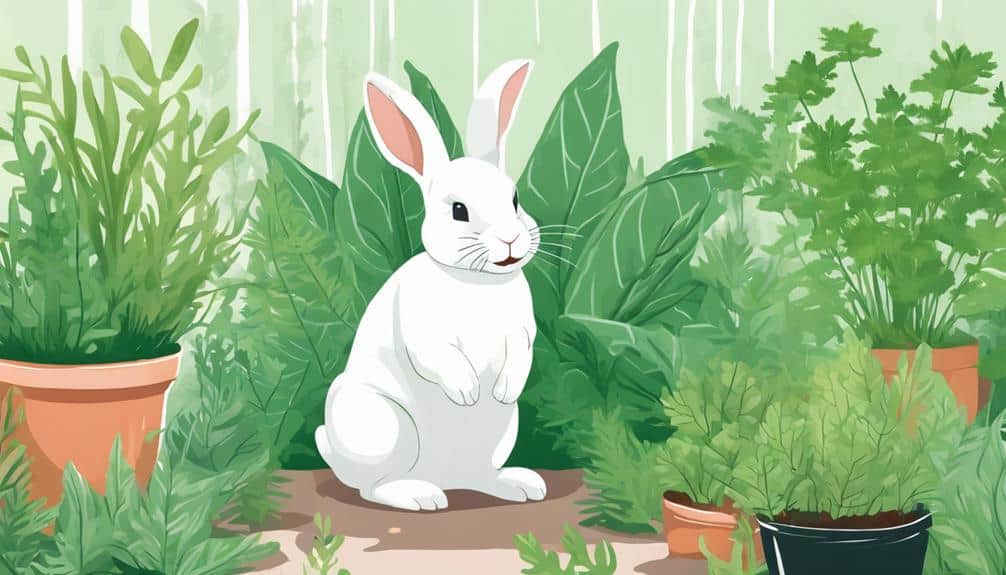
When selecting plants for your bunny's environment, prioritize non-toxic options like basil, cilantro, and dill to guarantee their safety and well-being. These bunny-friendly plants not only add a touch of greenery to their space but also provide a safe and enriching environment for your furry companions.
Here are some safe plant choices for bunnies:
- Basil: A fragrant herb that bunnies enjoy nibbling on.
- Cilantro: A flavorful herb rich in essential nutrients for your bunny.
- Dill: Another aromatic herb that bunnies find delightful.
- Parsley: A nutritious herb that bunnies can munch on.
- Mint: A revitalizing herb that bunnies may find invigorating.
Pet-Safe Food Practices
To guarantee the health and well-being of your beloved rabbits, it's essential to practice pet-safe food habits consistently. Avoid feeding your rabbits toxic foods like chocolate, caffeine, onions, garlic, and iceberg lettuce. Instead, provide a balanced diet consisting of hay, fresh vegetables, and high-quality pellets to meet their nutritional needs.
Be cautious with fruits and starchy vegetables, as overfeeding these can lead to digestive issues and obesity. Always make sure your rabbits have access to fresh water daily to keep them hydrated and prevent urinary tract problems.
For peak health, consider consulting with a veterinarian to create a customized diet plan tailored to your rabbit's individual needs and health requirements. This personalized approach can help address any specific dietary concerns or restrictions your rabbit may have, ensuring they receive the proper nutrition without risking their well-being.
Non-Toxic Cleaning Alternatives
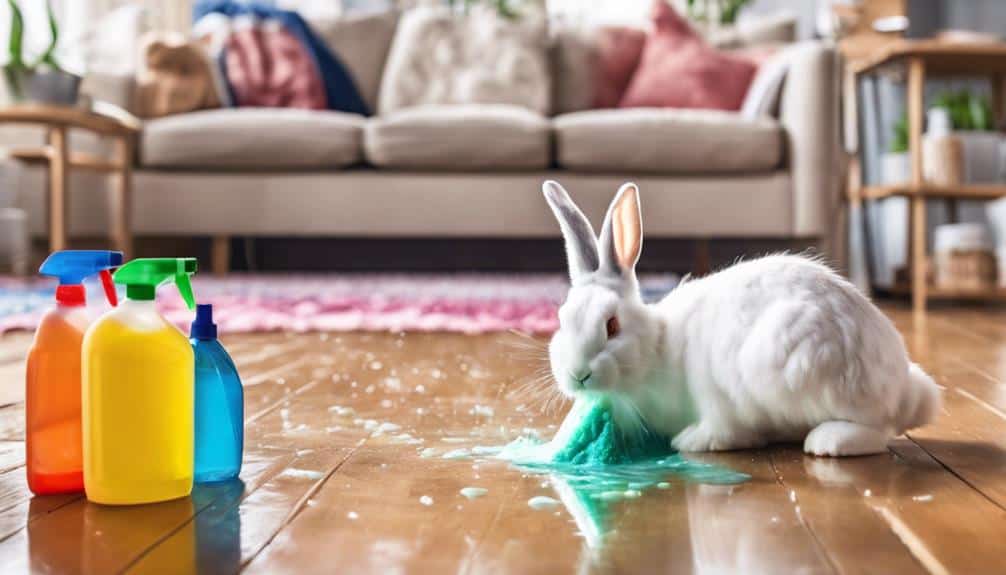
When it comes to keeping your bunnies safe and healthy, opting for non-toxic cleaning alternatives is essential. Using products like vinegar, baking soda, lemon juice, and hydrogen peroxide can effectively clean and sanitize their living spaces without exposing them to harmful chemicals.
These natural home cleaners provide a pet-friendly way to maintain a clean environment for your beloved rabbits.
Safe Cleaning Products
Wondering how you can keep your bunnies safe while cleaning their living space? It's important to use pet-safe cleaners and products to avoid harmful chemicals that can be toxic to rabbits. Here are some tips to guarantee a safe environment for your furry friends:
- Opt for non-toxic cleaning products.
- Avoid harmful chemicals that are toxic to rabbits.
- Use pet-safe cleaning alternatives.
- Consult a veterinarian for recommendations on safe cleaning products.
- Prioritize your rabbits' well-being by choosing non-toxic options to prevent accidental poisoning and health issues.
Keeping your bunnies safe from the dangers of conventional cleaning chemicals is essential for their health and happiness.
Natural Home Cleaners
Natural home cleaners offer a safe and effective way to maintain a clean environment for your bunnies without exposing them to harmful chemicals. Ingredients like vinegar, baking soda, and lemon can effectively clean your house without posing risks to your pets. These non-toxic options are kept in your house and can be used in various areas.
Hazardous chemicals found in traditional cleaners can cause harm to your furry friends, leading to potential poisonous exposure. By opting for natural cleaners, you lessen the risk of harm to your pets. These alternatives are a pet-friendly choice that not only keeps your space clean but also guarantees a safer living environment for your beloved bunnies.
Pet-Friendly Cleaning Tips
For a safe and healthy cleaning routine for your bunnies, opt for non-toxic cleaning alternatives that prioritize their well-being. When caring for your furry friends, consider the following pet-friendly cleaning tips:
- Use pet-safe cleaners to prevent harmful chemicals from affecting your rabbits.
- Prioritize non-toxic cleaning products to safeguard your bunnies from accidental ingestion of toxic substances.
- Consult a veterinarian before using scented sprays or oil diffusers around rabbits to avoid respiratory issues.
- Keep cleaning chemicals out of reach of rabbits to prevent accidental ingestion and poisoning.
- Practice safe cleaning habits to make certain your bunnies don't come into contact with harmful substances.
Creating a Bunny-Safe Play Area
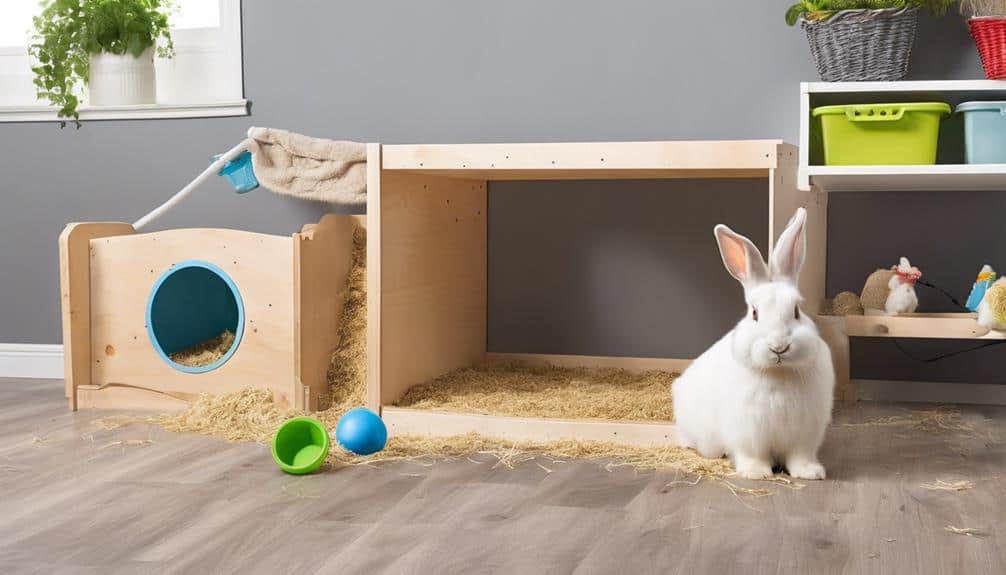
To create a safe play area for your bunny, designate a space that offers ample room for hopping and exploring freely. Guarantee the rabbit living area is free of dangerous household hazards like wires lying around, small objects that could be a choking hazard, and toxic plants. Bunny-proof the space by removing any potential risks and providing a variety of safe toys and enrichment activities for your furry friend.
Monitoring playtime is crucial to observe your bunny's behavior and ensure they stay safe and healthy. Make sure the play area is secure and escape-proof to prevent accidents or unwanted explorations.
Eliminating Slippery Surfaces
When creating a safe environment for your bunny, ensuring traction and stability by eliminating slippery surfaces is important to prevent accidents and injuries. To enhance safety in areas where your rabbit roams, consider the following tips:
- Use carpets or area rugs: Place carpets or area rugs on slippery floors to provide traction and prevent your bunny from slipping.
- Avoid polished or smooth surfaces: Minimize the risk of injuries by steering clear of polished or smooth flooring that can cause slips.
- Secure rugs in place: Prevent accidental slips or falls by securing rugs in place to avoid your rabbit pulling them.
- Utilize non-slip mats: Enhance stability for your bunny by using non-slip mats or rugs with rubber backing.
- Regular cleaning: Maintain a clean environment by regularly cleaning the floors to remove any substances or spills that could create slippery conditions.
Ensuring Proper Ventilation and Temperatures
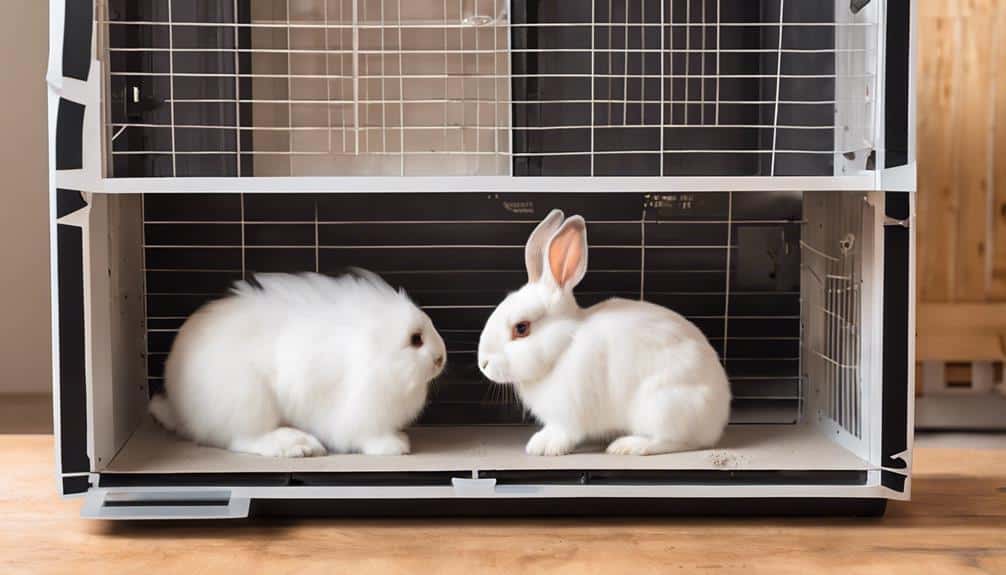
Ensuring proper ventilation and maintaining best temperatures is essential for creating a healthy and comfortable living environment for your rabbits. Proper ventilation is critical for preventing respiratory issues and ensuring good air quality for your rabbits. These sensitive animals are greatly affected by temperature extremes, so it's important to regulate indoor temperatures through adequate ventilation to keep them comfortable.
Ventilation helps in removing stale air, odors, and moisture, contributing to a healthier environment where rabbits can thrive.
Inadequate ventilation can lead to respiratory infections and discomfort for your rabbits, underlining the significance of proper airflow in their living space. By maintaining ideal temperatures through ventilation, you can prevent heat stress or hypothermia in your rabbits, ensuring their well-being. Paying attention to ventilation and indoor temperatures not only safeguards your rabbits from health issues but also creates a pleasant and comfortable environment for them to enjoy.
What Hazards Should I Be Aware of to Keep My Bunnies Safe?
When it comes to keeping your bunnies safe, it’s important to be aware of potential hazards. Common dangers for bunnies include toxic plants, electrical cords, and predators. By understanding these risks, you can create a safe environment for your pets. And to answer the question, no, bunnies cannot kill humans.
Frequently Asked Questions
What Are the Safety Hazards of Rabbits?
You should be cautious with your bunnies around toxic plants, sharp objects, electrical cords, small spaces, nearby predators, extreme temperatures, and unsafe toys. Keep them safe by removing hazards and creating a secure environment.
How Do Rabbits Protect From Danger?
When danger looms, rabbits rely on their instincts to survive. They burrow for safety, listen for threats, and bolt with lightning speed. Their strong kicks and thumping warnings show they're always vigilant against predators.
How Do You Keep Rabbits Safe?
You keep rabbits safe by being vigilant. Watch for outdoor dangers and predators nearby. Secure enclosures and bunny-proof indoors. Keep poisonous plants away, and supervise playtime. Your care guarantees their safety and well-being.
What Precautions Should Be Taken When Handling Rabbits?
When handling rabbits, always remember to support their hindquarters properly. Approach them gently, using a secure grip to make them feel safe. Supervise playtime with kids, rabbit-proof your home, and provide safe toys. Regular check-ups are essential for their health.
Conclusion
You've bunny-proofed your space, secured wires, and chosen safe plants.
You've stocked pet-friendly foods, swapped harsh cleaners, and set up a play area.
With no slippery floors, proper ventilation, and ideal temperatures, your bunny's safety is guaranteed.
Stay vigilant, provide love and care, and watch them thrive in their secure environment.
Your efforts will pay off in the form of a happy, healthy bunny companion.
Well done, bunny parent!

